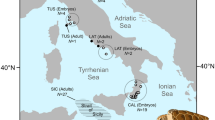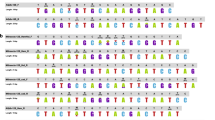Abstract
Anemonefish are iconic symbols of coral reefs and have become model systems for research on larval dispersal and population connectivity in coral reef fishes. Here we present 24 novel microsatellite markers across four species of anemonefish and also test 35 previously published markers for cross-amplification on two anemonefish species in order to facilitate further research on their population genetics and phylogenetics. Novel loci were isolated from sequences derived from microsatellite-enriched or 454 GS-FLX shotgun sequence libraries developed using congeneric DNA. Primer testing successfully identified 15 new microsatellite loci for A. percula, 4 for A. melanopus, 3 for A. akindynos, and 2 for A. omanensis. These novel microsatellite loci were polymorphic with a mean of 10 ± 1.6 SE (standard error) alleles per locus and an average observed heterozygosity of 0.647 ± 0.032 SE. Reliable cross-amplification of 12 and 26 of the 35 previously published Amphiprion markers was achieved for A. melanopus and A. akindynos, respectively, suggesting that the use of markers developed from the DNA of congeners can provide a quick and cost-effective alternative to the isolation of new loci. Together, the markers presented here provide an important resource for ecological, evolutionary, and conservation genetic research on anemonefishes that will inform broader conservation and management actions for coral reef fishes.
Similar content being viewed by others
References
Alberto F (2009) MsatAllele_1.0: an R package to visualize the binning of Microsatellite alleles. J Hered 100:394–397. doi:10.1093/jhered/esn110
Beldade R, Holbrook SJ, Schmitt RJ, Planes S, Bernardi G (2009) Isolation and characterization of eight polymorphic microsatellite markers from the orange-fin anemonefish, Amphiprion chrysopterus. Conserv Genet Resour 1:333–335. doi:10.1007/s12686-009-9077-9
Berumen ML, Almany GR, Planes S, Jones GP, Saenz-Agudelo P, Thorrold SR (2012) Persistence of self-recruitment and patterns of larval connectivity in a marine protected area network. Ecol Evol 2:444–452. doi:10.1002/ece3.208
Buston PM, Bogdanowicz SM, Wong A, Harrison RG (2007) Are clownfish groups composed of close relatives? An analysis of microsatellite DNA variation in Amphiprion percula. Mol Ecol 16:3671–3678. doi:10.1111/j.1365-294X.2007.03421.x
Buston PM, Jones GP, Planes S, Thorrold SR (2012) Probability of successful larval dispersal declines fivefold over 1 km in a coral reef fish. Proc R Soc B 279:1883–1888. doi:10.1098/rspb.2011.2041
Harrison HB, Williamson DH, Evans RD, Almany GR, Thorrold SR, Russ GR, Feldheim KA, van Herwerden L, Planes S, Srinivasan M, Berumen ML, Jones GP (2012) Larval export from marine reserves and the recruitment benefit for fish and fisheries. Curr Biol 22:1023–1028. doi:10.1016/j.cub.2012.04.008
Hellberg ME (2009) Gene flow and isolation among populations of marine animals. Ann Rev Ecol Evol Syst 40:291–310. doi:0.1146/annurev.ecolsys.110308.120223
Hobbs J-PA, Frisch AJ, Ford BM, Thums M, Saenz-Agudelo P, Furby KA, Berumen ML (2013) Taxonomic, spatial and temporal patterns of bleaching in anemones inhabited by anemonefishes. PLoS One 8:e70966
Lawton RJ, Messmer V, Pratchett MS, Bay LK (2011) High gene flow across large geographic scales reduces extinction risk for a highly specialised coral feeding butterflyfish. Mol Ecol 20:3584–3598. doi:10.1111/j.1365-294X.2011.05207.x
Nanninga G, Mughal M, Saenz-Agudelo P, Bayer T, Berumen M (2013) Development of 35 novel microsatellite markers for the two-band anemonefish Amphiprion bicinctus. Conserv Genet Resour 5:515–518. doi:10.1007/s12686-012-9841-0
Nanninga GB, Saenz-Agudelo P, Manica A, Berumen ML (2014) Environmental gradients predict the genetic population structure of a coral reef fish in the Red Sea. Mol Ecol 23:591–602. doi:10.1111/mec.12623
Pinsky ML, Montes HR Jr, Palumbi SR (2010) Using isolation by distance and effective density to estimate dispersal scales in anemonefish. Evol 64:2688–2700. doi:10.1111/j.1558-5646.2010.01003.x
Planes S, Jones GP, Thorrold SR (2009) Larval dispersal connects fish populations in a network of marine protected areas. Proc Natl Acad Sci U S A 106:5693–5697. doi:10.1073/pnas.0808007106
Quenouille B, Bouchenak-Khelladi Y, Hervet C, Planes S (2004) Eleven microsatellite loci for the saddleback clownfish Amphiprion polymnus. Mol Ecol Notes 4:291–293. doi:10.1111/j.1471-8286.2004.00646.x
Raymond M, Rousset F (1995) GENEPOP (version 1.2): population genetics software for exact tests and ecumenicism. J Hered 86:248–249
Rousset F (2008) GENEPOP ’ 007: a complete re-implementation of the GENEPOP software for Windows and Linux. Mol Ecol Res 8:103–106. doi:10.1111/j.1471-8286.2007.01931.x
Saenz-Agudelo P, Jones GP, Thorrold SR, Planes S (2011) Connectivity dominates larval replenishment in a coastal reef fish metapopulation. Proc R Soc B 278:2954–2961. doi:10.1098/rspb.2010.2780
Saenz-Agudelo P, Jones GP, Thorrold SR, Planes S (2012) Patterns and persistence of larval retention and connectivity in a marine fish metapopulation. Mol Ecol 21:4695–4705. doi:10.1111/j.1365-294X.2012.05726.x
Sato M et al. (2014) Fifteen novel microsatellite markers for two Amphiprion species (Amphiprion frenatus and Amphiprion perideraion) and cross-species amplification. Conserv Genet Resour :1–4. doi:10.1007/s12686-014-0182-z
Selkoe KA, Toonen RJ (2006) Microsatellites for ecologists: a practical guide to using and evaluating microsatellite markers. Ecol Lett 9:615–629. doi:10.1111/j.1461-0248.2006.00889.x
Shuman CS, Hodgson G, Ambrose RF (2005) Population impacts of collecting sea anemones and anemonefish for the marine aquarium trade in the Philippines. Coral Reefs 24:564–573
Timm J, Planes S, Kochzius M (2012) High similarity of genetic population structure in the false clown anemonefish (Amphiprion ocellaris) found in microsatellite and mitochondrial control region analysis. Conserv Genet 13:693–706. doi:10.1007/s10592-012-0318-1
van der Meer MH, Jones GP, Hobbs JPA, van Herwerden L (2012a) Historic hybridization and introgression between two iconic Australian anemonefish and contemporary patterns of population connectivity. Ecol Evol 2:1592–1604. doi:10.1002/ece3.251
van der Meer MH, Gardner MG, Hobbs J-PA, Jones GP, van Herwerden L (2012b) Identification of seventeen microsatellite markers for conservation genetic studies of the endemic anemonefish, Amphiprion mccullochi. Conserv Genet Res 4:247–250. doi:10.1007/s12686-011-9517-1
van der Meer MH, Horne JB, Gardner MG, Hobbs JPA, Pratchett MS, van Herwerden L (2013) Limited contemporary gene flow and high self-replenishment drives peripheral isolation in an endemic coral reef fish. Ecol Evol 3:1653–1666. doi:10.1002/ece3.584
Acknowledgments
We are grateful to the many volunteers who assisted with sample collections, including Thomas Mannering, Rohan Brooker, Lisa Boström-Einarsson, Scott Hansen, Dylan Simonson, and Tessa Hempson. This project was supported by the King Abdullah University of Science and Technology (KAUST) (Awards CRG-1-2012-BER-002, OCRF-SPCF-2011-BER-001, and baseline research funds to MLB) and the Australian Government’s National Environmental Research Program (NERP) Tropical Ecosystems Hub (Project 8.3). Additional support was provided by the Australian Research Council (ARC) Centre of Excellence for Coral Reef Studies, the KAUST Red Sea Research Center, and the KAUST Biosciences Core Laboratory.
Author information
Authors and Affiliations
Corresponding author
Additional information
Communicated by P. Martinez Arbizu
Rights and permissions
About this article
Cite this article
Bonin, M.C., Saenz-Agudelo, P., Harrison, H.B. et al. Characterization and cross-amplification of microsatellite markers in four species of anemonefish (Pomacentridae, Amphiprion spp.). Mar Biodiv 46, 135–140 (2016). https://doi.org/10.1007/s12526-015-0336-6
Received:
Revised:
Accepted:
Published:
Issue Date:
DOI: https://doi.org/10.1007/s12526-015-0336-6




